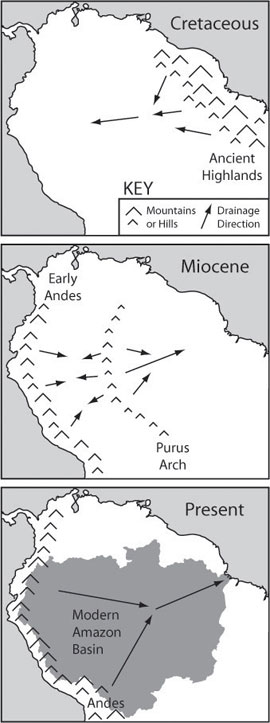Amazon river flowed into the Pacific millions of years ago
Amazon river flowed into the Pacific millions of years ago
mongabay.com
October 24, 2006
A new study adds further evidence the theory that the world’s largest river, the Amazon, once flowed in the opposite direction, emptying into the Pacific Ocean.
Researchers at the University of North Carolina at Chapel Hill (UNC) discovered “ancient mineral grains” in the central Amazon that could only have originated in now-eroded mountains that once existed in the central and eastern South America, not the more recently formed Andes in the west.
Russell Mapes, a geology graduate student at the University of North Carolina at Chapel Hill and co-author of the research, explained the origin in a news release from UNC
-
[T]hese sediments of eastern origin were washed down from a highland area that formed in the Cretaceous Period, between 65 million and 145 million years ago, when the South American and African tectonic plates separated and passed each other. That highland tilted the river’s flow westward, sending sediment as old as 2 billion years toward the center of the continent…
Toward the end of the Cretaceous, the Andes started growing, which sent the river back toward the Purus Arch. Eventually, sediment from the mountains, which contained mineral grains younger than 500 million years old, filled in the basin between the mountains and the arch, the river breeched it and started its current flow.

|
“Although the Amazon seems permanent and unchanging it has actually gone through three different stages of drainage since the mid-Cretaceous, a short period of time geologically speaking,” said Mapes.
Mapes’ advisor, Dr. Drew Coleman, a professor of geology in UNC’s College of Arts and Sciences, participated in the research as did Afonso Nogueira and Angela Maria Leguizamon Vega of the Universidade Federal do Amazonas.
Earlier research has also suggested a westward-flowing Amazon, perhaps as part of a proto-Congo river system from the interior of present day Africa when the continents were joined as part of Gondwanaland. Fifteen million years ago, the Andes were formed by the collision of the South American plate with the Nazca plate. The rise of the Andes and the linkage of the Brazilian and Guyana bedrock shields, blocked the river and caused the Amazon to become a vast inland sea. Gradually this inland sea became a massive swampy, freshwater lake and the marine inhabitants adapted to life in freshwater. For example, over 20 species of stingray, most closely related to those found in the Pacific Ocean, can be found today in the freshwaters of the Amazon.
About ten million years ago, waters worked through the sandstone to the west and the Amazon began to flow eastward. At this time the Amazon rainforest was born. During the Ice Age, sea levels dropped and the great Amazon lake rapidly drained and became a river, which would eventually become the world’s largest, draining the most extensive expanse of rainforest on the planet.
RELATED ARTICLES
Weight of flooded Amazon river causes Earth to sink 3 inches.
As the Amazon River floods every year, a sizeable portion of South America sinks several inches because of the extra weight — and then rises again as the waters recede, a study has found. This annual rise and fall of earth’s crust is the largest ever detected, and it may one day help scientists tally the total amount of water on Earth.
Rainforest rivers.
Tropical rainforests have some of the largest rivers in the world, like the Amazon, Madeira, Mekong, Negro, Orinoco, and Zaire (Congo), because of the tremendous amount of precipitation their watersheds receive. These mega-rivers are fed by countless smaller tributaries, streams, and creeks. For example, the Amazon alone has some 1,100 tributaries, 17 of which are over 1,000 miles long. Although large tropical rivers are fairly uniform in appearance and water composition, their tributaries vary greatly. Many tropical rivers and streams have extreme high and low water levels that occur at different parts of the year.
This article uses quotes from a UNC news release and previous mongabay.com articles.















